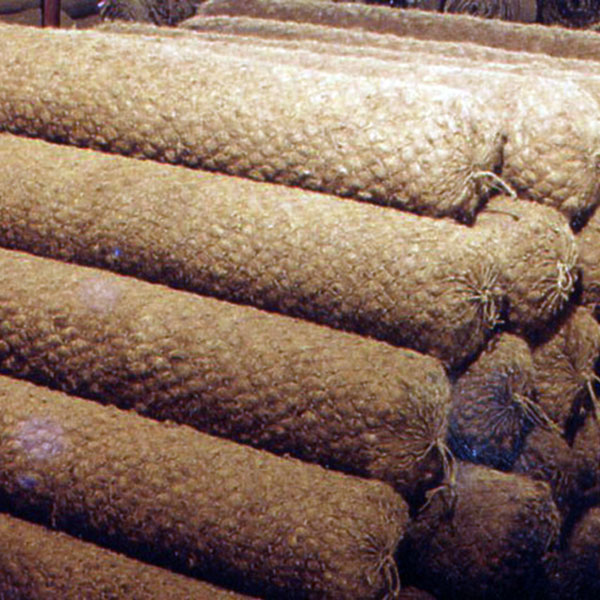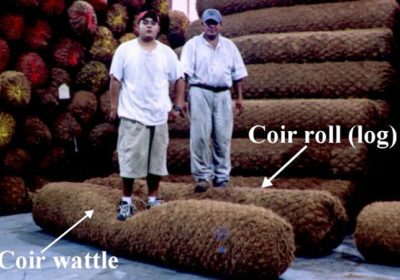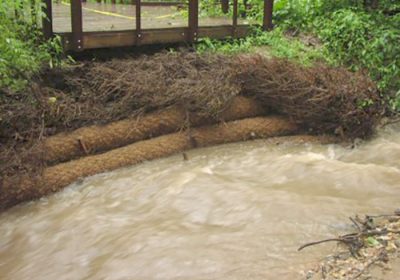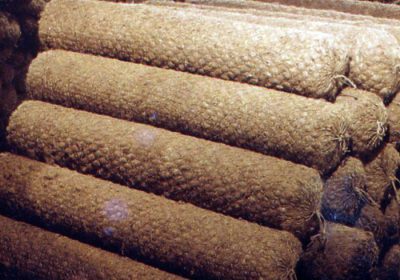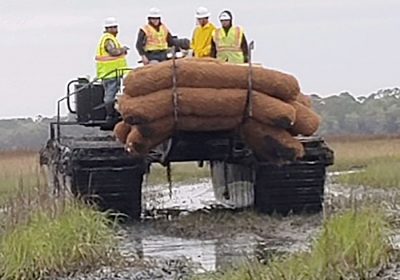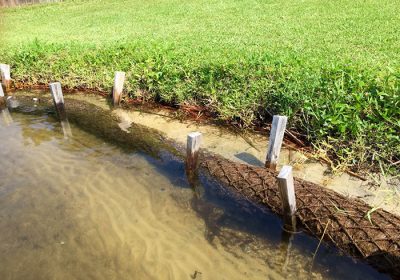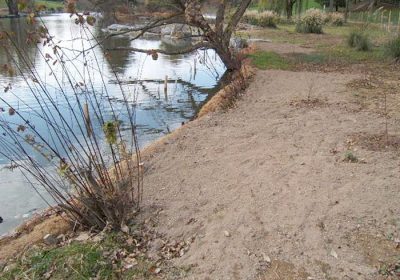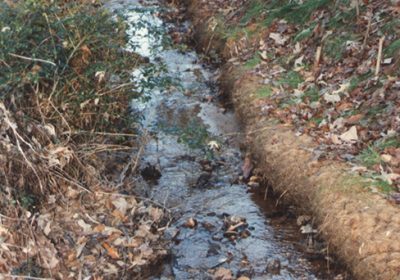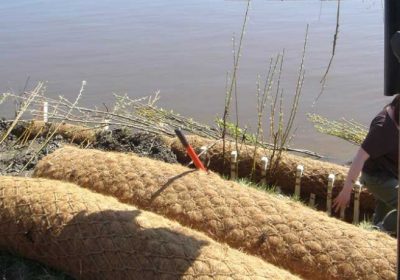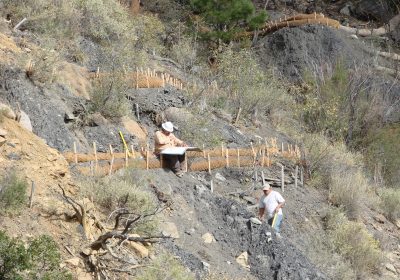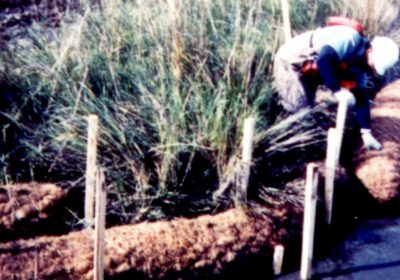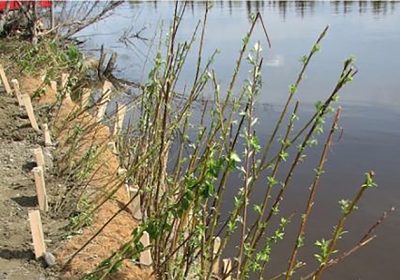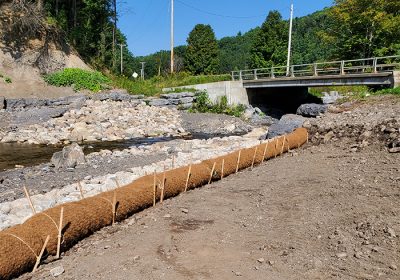High density coir logs for streambank restoration
An excellent natural tool for toe protection
BioD-Roll™ coir logs are completely biodegradable and do not contain any synthetic materials to harm wildlife.
RoLanka’s BioD-Roll™ coir logs (coir rolls) are made of mattress coir fiber densely packed into a tubular net made with bristle coir twine. The strong and durable outer net in these coir logs has 2 in x 2 in (5 cm x 5cm) openings. These heavy-duty coir logs provide structural stability for shorelines and streambanks by resisting wave action and flow velocity. The coir fiber core in coir logs is an excellent medium for plant growth. After installing the coir logs, desired native plants should be planted on or around coir logs where plants can get enough water. With time, plants grow on coir logs. With time, sediment will be deposited around the coir logs, creating an excellent medium for riparian vegetation. The outer net of these densely packed coir logs lasts at least for three years, and the inner core will last more than 10 years. These high-density coir logs provide erosion resistance and support the establishment of sustainable mature vegetation. RoLanka’s BioD-Roll™ coir logs are available in 12 in (30 cm), 16 in (40 cm), and 20 in (50 cm) diameters and 10-ft long sections.
BioD-Roll coir logs are densely packed to provide support to streambanks and other types of shorelines.
Resources
Print specification of BioD-Roll coir logs
Specifications of BioD-Roll coir logs
The fabric attached BioD-Block system is available in 12-in and 16-in tall blocks.
| Property | BioD-Roll™ 30L | BioD-Roll™ 30H | BioD-Roll™ 40 | BioD-Roll™ 50 |
| Diameter | 12 inches (30 cm) | 12 inches (30 cm) | 16 inches (40 cm) | 20 inches (50 cm) |
| Weight | 5 lbs./ft. (7.5 kg/m) | 7 lbs./ft. (10.4 kg/m) | 12.4 lbs./ft. (18.5 kg/m) | 19.4 lbs./ft. (28.9 kg/m) |
| Density | 7 lbs./ft3 (112 kg/m3) | 9 lbs./ft3 (144 kg/m3) | 9 lbs./ft3 (144 kg/m3) | 9 lbs./ft3 (144 kg/m3) |
| Length | 10 feet. (3.05 m) | 10 feet (3.05 m) | 10 feet (3.05 m) | 10 feet (3.05 m) |
| Outer net | 90 lbs. (400 N) | 90 lbs. (400 N) | 90 lbs. (400 N) | 90 lbs. (400 N) |
| Net strength | Bristle coir twine net | Bristle coir twine net | Bristle coir twine net | Bristle coir twine net |
| Net type | 2 in. x 2 in. | 2 in. x 2 in. | 2 in. x 2 in. | 2 in. x 2 in. |
| Net opening | (5 cm x 5 cm) | (5 cm x 5 cm) | (5 cm x 5 cm) | (5 cm x 5 cm) |
| Inner core | Mattress coir fiber | Mattress coir fiber | Mattress coir fiber | Mattress coir fiber |
Applications
- Slope stabilizations
- Streambank stabilization
- Riverbank stabilization
- Lake shoreline stabilization
- Reservoir shoreline stabilization
- Beach restoration
- Mine restoration
- Wetland restoration
Always use dry coir logs (rolls)
Use of vegetated coir logs in environmental restorations will significantly increase the cost of restoration. Use dry coir logs for economical and effective environmental restorations.
- Coir fiber is strong, durable, and versatile.
The objective of using strong, durable coir products in environmental restoration is to provide necessary initial protection for the site until mature vegetation is established. Dry coir products provide maximum protection. Once these 100% organic and biodegradable coir products are exposed to water, they begin to decompose. - Vegetated coir logs are partially decomposed.
When coir logs are vegetated in nurseries, they begin the process of biodegradation. When the vegetated coir logs are ready to install in the field, they are already partially decomposed. This will significantly shorten their lifespan as well as the strength of coir logs. For this reason, vegetated coir logs to provide much less erosion protection than dry coir logs. - Transportation of vegetated coir logs is extremely expensive.
Transporting and handling partially degraded coir logs is difficult and labor intensive. Vegetated coir logs need 10-times more truck space. Transporting vegetated coir logs for long distance is not an option as the young plants can wither easily any may die at the site. With current higher fuel prices and labor costs, restoration with vegetated coir logs not an economical option. The larger diameter dry coir logs (20 in.) are difficult to handle and it is impossible to handle with plants on them. - Young plants on vegetated coir logs damage easily during transportation.
The young native plants growing on coir logs are delicate and need special attention. Accesses to most of the restoration sites are difficult too. There is a good chance that plants will be damaged during transportation which will destroy all the effort used to grow them. It will be extremely difficult to take vegetated coir logs to restoration sites without damaging the plants. - Timing of installation is critical.
In a practical sense, it is difficult to time the construction of any project due to various reasons. A major limiting factor of the vegetated coir logs is that they need to be transported when the plants are ready. If a project gets delayed due to weather or any other uncontrollable event, the vegetated logs are wasted unnecessarily. - Need more nursery space to vegetate the coir logs.
Normally nursery grown native plants are use with dry coir logs installations. The space needed for these plants are smaller compared to growing these plants on coir logs.


